Homework Set I (1/21)
This assignment is for discussion in class (except as called "Hand In"). Come up with ANY IDEAS at all and bring them along!
Due Thurs., 1/22:
##A1, A2, A4 for G = G1 (do this first) and G2, G4.
Also, read to page 8 in the textbook.
Due Fri. 1/23:
#A3 (again, do G1 first).
Hand in Fri. 1/23:
##A1, A2, A4 for G3.
Problem Set A
Some terminology about a graph:
- Order:
- the number of vertices.
- Size:
- the number of edges.
- Separating set:
- a set of vertices whose removal leaves a disconnected graph.
- Disconnecting set:
- a set of vertices whose removal leaves a disconnected graph.
A1. (a) Find a separating set.
(b) Find one that is smallest.
A2. (a) Find a disconnecting set.
(b) Find one that is smallest.
A3. Write down the degree sequence of G = G1, G2, G3. (Omit G4.)
A4. Treat G as a graph in which the vertices stand for people and the edges join pairs who don't get along together, so they can't be on the same committee. What is the largest possible committee?
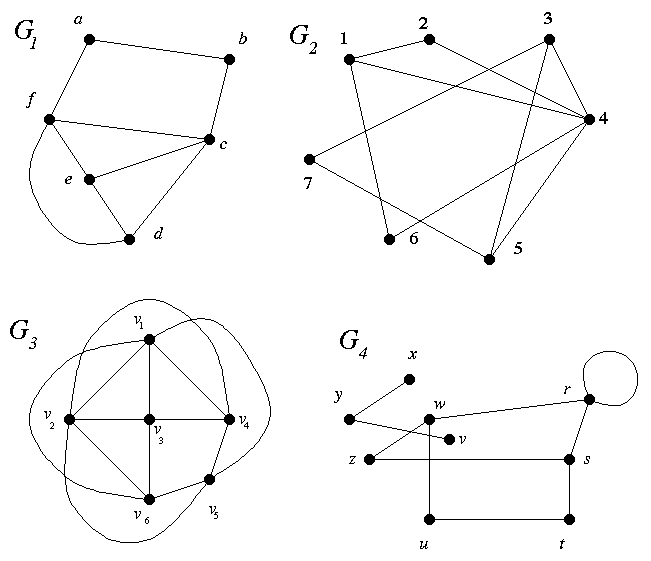
Hand in Thurs., 1/29:
AA1. This problem concerns ways of testing graphs for being isomorphic or nonisomorphic. In each part, suppose G and H are isomorphic graphs.
The point is that, if G and H are graphs that fail any one of these properties, then they cannot be isomorphic (by contradiction). But the converse is not true, as the next problem shows.
AA2. For each property in # 1, find a pair of graphs, G and H, that are not isomorphic but which fail the property. Specifically, do these:
For Mon. 1/26: Read Sections 1.1, 1.2.
Do for discussion Thurs. 1/29:
Do for discussion Fri. 1/30:
Hand in Mon. 2/2:
Definitions will be found on the announcements page.
B1. This concerns Theorem 1.1.2 and the example G0. I'll follow the book's notation. NOTE: There are some errors in this question. The corrected version is Problem # BB1 in HW Set IIa (see below).
The sequence
B2. In which graphs is the whole vertex set V the only separating set?
B3. In G2 from Homework I, find the values of (a) kappa(1, 5), (b) kappa(2, 6). Use Menger's Vertex Theorem to prove you are correct: i.e., find the internally disjoint paths that the theorem tells us exist.
B4. The same as B3, but for kappa(v3, v5) in G3 from Homework I.
Do for discussion Thurs. 2/5 (additional problem):
BB1. This concerns Theorem 1.1.2 and the example G0. I'll follow the book's notation.
The sequence
For Mon. 2/2: Read Section 1.3.
Do for discussion Thurs. 2/5:
Do for discussion Fri. 2/6:
Hand in Mon. 2/9:
C1. CORRECTION: Omit this problem.
C2. In the graph F of Figure 1.1.16:
C3. Let G be a graph which has a cycle. Let C be a cycle in G. Let a, b be arbitrary vertices in G, and let e be any edge in C. Explain why, if G has a path connecting a to b, so does G - e.
C4. Show that the graph G0 is not a tree by using the proof of the first half of Theorem 1.3.5. Namely, pick any two paths you like between a and e, and use the method in the proof to contruct a cycle in G0.
C5. In G2 from Homework I, find the values of
Use Menger's Edge Theorem to prove you are correct: i.e., find the pairwise edge-disjoint paths that the theorem tells us exist.
C6. The same as C5, but for lambda(v3, v5) in G3 from Homework I.
For Mon. 2/9: Read Section 2.1.
Do for discussion Thurs. 2/12:
Do for discussion Fri. 2/13:
Hand in Mon. 2/16:
D1. Suppose the average degree of a graph G is > 2.
D2. Suppose G is a connected graph whose average degree is 3.
D3. Find the chromatic number chi(G) where G is the graph in Figure 2.1.5.
D4. Is the graph of Figure 2.1.5 critical? Prove. (Don't believe everything you read!)
D5. Is the graph of Figure 2.1.6 critical? Prove.
For Mon. 2/23: Read Sections 2.2, 2.3.
Do for discussion Thurs. 2/26:
Do for discussion Fri. 2/27:
Hand in Mon. 3/1:
E1. Prove there is no 1-factor in the graph of Figure 2.2.6 (a) left, (b) right.
E2. Is the graph of Figure 2.1.2 critical? Prove.
E3. Let V(K2n) = {0, 1, 2, ..., 2n-2, x}. We have a standard way to decompose K2n into 1-factors (see Section 2.2). In K8, which "standard" 1-factor contains the following edge? (For your answer you may list all edges that belong to the 1-factor.)
Read Section 2.4.
Do for discussion Thurs. March 4:
Do for discussion Fri. March 5:
Hand in Mon. March 8:
F1. Find a Hamilton cycle or prove there is none.
F2. Let V(K2n+1) = {0, 1, 2, ..., 2n-1, x}. We have a standard way of decomposing K2n+1 into Hamilton cycles (see Section 2.3). In K11, which "standard" Hamilton cycle contains the edge
F3. Prove that Kp can be decomposed into p - 1 paths P1, P2, ..., Pp-1 for all values of p, not only the even values to which Theorem 2.3.4 applies.
F4. Verify that, in the proof of Theorem 2.3.2, the first two 1-factors unite to form a Hamilton cycle. Your proof should be valid for all n >= 2.
Read Section 3.1.
Do for discussion Wed. March 10:
Hand in Mon. March 15:
See the corrections for Section 3.1.
G1. Decompose into the fewest possible trails:
G2. Decompose into the fewest possible paths: (a, b, c) as in #G1.
G3. Decide whether the graph is Hamiltonian:
Read Sects. 3.2 and 3.3.
Do for discussion Thurs. 3/18:
Do for discussion Fri. 3/19:
Hand in Mon. 3/22:
In Exercise 3.3.17, the graph you find should also be connected, in addition to the other properties that were specified.
H1. (a) Find a graph E which has an Eulerian circuit but no Hamilton cycle.
H2. Produce a decomposition of Fig. 3.2.8 into two 2-factors, using the method of proof of Theorem 3.1.4.
H3. Correction: This is the same as # F3. Please omit. Prove that Kp can be decomposed into p - 1 paths P1, P2, ..., Pp-1 for all values of p, not only the even values to which Theorem 2.3.4 applies.
H4. For ambitious students, prove:
Do for discussion on Mon. 3/22:
Do for discussion on Wed. 3/24:
HH1. Use the proof method of Theorem 3.2.4 to decompose into subgraphs isomorphic to P3 :
HH2. Use the proof method of Theorem 3.1.7 (Listing's Theorem) to decompose into the smallest possible number of trails:
HH3. Do your best to give a correct proof that, in the infinite graph G shown here, each of the three lobes hanging off vertex x has a 1-way Eulerian trail. (All the lobes are the same, but I only drew a large part of one of them.)
For Mon. 3/29:
Do for discussion Thurs. 4/1:
Do for discussion Fri. 4/2:
Hand in Wed. 4/14:
I1. This question concerns the proof of Theorem 4.1.2* (that is, the base case k = 2 of Turan's Theorem). You are given the ``starting'' graph G of the proof, which has no triangle.
I2. The uniqueness of the maximum graph in Theorems 4.1.2* and 4.1.2 is not proved in the book.
Read Sect. 8.1 and Sect. 9.1. The proof of Theorem 9.1.7 is optional. The most interesting thing about the proof of Theorem 9.1.6 is that it uses Turán's Theorem!
Do for discussion Thurs. 4/15:
Do for discussion Fri. 4/16:
Hand in Mon. 4/19:
J1. Let G be the Grötzsch graph (Fig. 2.1.6).
J2. Find chi'(Z) where Z is the graph of Fig. 2.3.1.
J3. Show that the graph of Fig. 9.1.16 is nonplanar.
J4. Planar or nonplanar? Prove it!
J5. Prove that K3,3 is the unique 4-cage.
Read for Mon. 4/19: Sect. 8.3; and also Sect. 8.2, omitting the part about edge 3-coloring (Theorem 8.2.1, Theorems 8.2.3-5, and Theorem 8.2.7). The points to focus on are: coloring a map, mormal maps, Lemma 8.2.2, and the dual graph.
Read for Wed. 4/21: Sect. 8.4.
Do for discussion Thurs. 4/22:
Do for discussion Fri. 4/23:
Hand in Mon. 4/26:
K1. Prove that cr(P) >= 2, where P is the Petersen graph.
K2. (a) Prove that, if p >= 11, then Kp has no decomposition into two planar graphs.
K3. Do both (i) and (ii) for
(i) Is the graph planar?
(ii) Find the crossing number. If you can't calculate it exactly, find out as much as you can about it. For instance, is it = 0 or > 0? Is it = 1? = 2? >= 2? >= 3? Can you find any upper bound?
K4. Write a complete proof of the 6-Color Theorem: Every planar graph can be colored in 6 colors. (Hint: Try induction on the number of vertices.)
Do for discussion Mon. 4/26:
Do for discussion Wed. 4/28:
Theorem L. If G is a planar graph and has girth g (where 3 <= g < infinity), then q <= [g/(g-2)](p-2).
L1. Use Theorem L to solve:
L2. Use Theorem L to do (a, b, d).
L3. Prove Theorem L.
L4. Prove that cr(K6 - edge) >= 2.
Read Sects. 9.2 and 9.3.
Do for discussion Wed. 5/5:
Do for discussion Thurs. 5/6:
Hand in Thurs. 5/6:
M1. Find theta(P), where P is the Petersen graph.
M2. Prove that theta(Kn) >= ceiling[(n+2)/6] for all n >= 1.
M3. Let c(G) = the number of cycles in the graph G.
M4. Let H = Heawood graph, Fig. 4.2.4.
M5. Prove sigma(P) >= 2, where P = Petersen graph. (Thus sigma(P) = 2, by Exercise 9.3.4.)
These problems are for extra study; they are recommended but not required. They may need more thought than most of the homework problems have. We may discuss them in class during the last days.
N1. Let N5 = {1,2,3,4,5}. Define a graph G5 by V(G5) = the set of all unordered pairs ij of elements of N5, with two pairs ij and kl adjacent if their intersection is empty.
N2. The graph G2 is shown. Find out as much as you can about its crossing number.
N3. (a) Find a largest graph with 11 vertices and all degrees divisible by 3. (b) Even better, find all (nonisomorphic) largest such graphs.
N4. In class we proved that theta(G) <= cr(G)+1. Can you improve on this, e.g., by reducing the upper bound?
Homework Set Ia (1/28)
## AA1, AA2.
Do at least parts (a); do more if you can in a reasonable amount of time. Don't spend a lot of time on these questions.
Problem Set AA
Homework Set II (1/23)
Sect. 1.1, ## 1, 2, 4(a-c), 6, 9(a).
Sect. 1.2, # 1, 5, 7, 8.
# B3(a).
Sect. 1.2, ## 2, 3.
## B1, B2, B3(b).
Sect. 1.1, ## 3, 4(d), 5, 7, 8, 9(b).
Sect. 1.2, ## 4, 6.
# B4.
Problem Set B
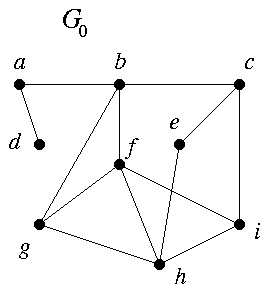
(S1) (4, 4, 4, 3, 3, 3, 2, 2, 1)
is known to be graphic, because it is the degree sequence of G0. From (S1) the rule of Theorem 1.1.2 gives
(S2) (3,3,2,2,3,2,2,1).
Homework Set IIa (1/30)
# BB1.
Problem Set BB

(S1) (4, 4, 4, 3, 3, 3, 2, 2, 1)
is known to be graphic, because it is the degree sequence of G0. From (S1) the rule of Theorem 1.1.2 gives
(S2) (3,3,2,2,3,2,2,1),
which, rearranged in descending order, is
(S3) (3,3,3,2,2,2,2,1).
Homework Set III (1/23)
Sect. 1.2, # 9 (graphs 1 and 3 only).
Sect. 1.3, ## 1, 2, 5, 11.
## C2, C5(a).
Sect. 1.3, ## 12-14, 16.
## C3, C5(b).
Sect. 1.2, # 10 and the rest of # 9.
Sect. 1.3, # 7.
## C1, C4, C7.
Problem Set C
(a) Find a longest path P. (Call its endpoints x and y.)
(b) Pick an edge e of P which lies in a cycle of F. In F - e, find a path connecting x and y.
(c) Pick an edge f of P which does not lie in a cycle of F. In F - f , is there a path connecting x and y?

(a) lambda(1, 5), (b) lambda(2, 6).
Homework Set IV (2/6-9)
Sect. 2.1, ## 1-4, 8, 13, 18, and 9-10 (for P5, K4,4, D, and O).
## D1, D3.
Sect. 2.1, ## 6, 11, 14, 16, 17.
# D4.
Sect. 2.1, ## 5, 7, 15(a), 19, 20, and 9-10 (for I).
## D2, D5.
Corrections
(a) any critical subgraph;
(b) a critical subgraph whose chromatic number equals that of the whole graph.
Problem Set D
(a) Prove that G contains at least 2 cycles.
(b) Prove that it is possible for G to have exactly 2 cycles.
(a) Show that G has at least 4 cycles.
(b) Is 4 the best possible number? Or can you prove that G must have 5 or more cycles? 6 or more?
Homework Set V (2/20)
Sect. 2.2, ## 3, 5, 6, 8, 9.
Sect. 2.3, ## 1, 3, 5.
## E1(a), E3(a).
Sect. 2.3, ## 4, 6-7 (for Q3 and I), 8, 10, 18(a).
## E2, E3(b-c).
Sect. 2.2, ## 4, 7, 10.
Sect. 2.3, ## 2, 5-7 (for D), 18(c).
## E1(b), E3(d).
Corrections
n-1, n-2, n, n-3, n+1, n-4, ..., 2n-2, 2n-1, x.
(This is actually equivalent to the printed line, but the printed line doesn't follow the pattern it's supposed to.)
Problem Set E
(a) 23.
(b) 2x.
(c) 36.
(d) 15.
Homework Set VI (2/27)
Sect. 2.3, ## 12, 17.
Sect. 2.4, ## 1, 3, 5, 8, 10.
## F1(a, b), F2(a).
Sect. 2.3, # 18(b).
Sect. 2.4, ## 4, 12, 21.
## F1(d), F2(b, c), F4.
Sect. 2.4, ## 7, 9 (Fig. 2.3.7), 22, 25.
## F1(c), F2(d), F3.
Problem Set F
(a) Figure 2.3.4.
(b) Figure 2.3.5. (Hint: it isn't!)
(c) Figure 2.3.7.
(d) Figure 2.1.6.
(a) 23 ?
(b) 3x ?
(c) 46 ?
(d) 37 ?
Homework Set VII (2/27)
Sect. 3.1, ## 1-3, 4 (for I, D, K4,4 only), 7, 8, 11, 14.
## G1(a), G2(a), G3.
Sect. 3.1, ## 1 (for O), 5, 6, 12, 13, 15, 16.
## G1(b, c), G2(b, c), G3(b).
Problem Set G
(a) Fig. 1.2.3 (left).
(b) Fig. 2.1.9.
(c) Fig. 2.2.6 (right).
(a) Fig. 2.1.3.
(b) Fig. 2.1.6.
Homework Set VIII (3/10)
Sect. 3.2, ## 1-3, 8.
Sect. 3.3, ## 1-4, 6.
Sect. 3.2, ## 4, 6.
Sect. 3.3, ## 7, 8, 17.
## H1, H2.
Sect. 3.2, ## 5.
Sect. 3.3, ## 16, 20.
## H3, H4.
Correction
Problem Set H
(b) Find a graph H which has a Hamilton cycle but no Eulerian circuit.
Lemma H4. In a pseudograph G, if there is a trail with endpoints a and b, then there is a path with endpoints a and b.
Homework Set VIIIa and Problem Set HH (3/17)
## HH1(a), HH2(a).
## HH1 and HH2: in each, do one or two of (b,c,d).
# HH3.
Problem Set HH
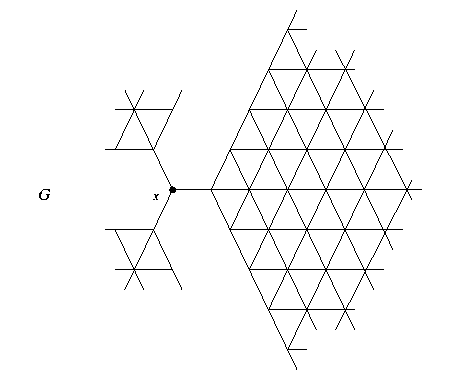
Homework Set IX and Problem Set I (3/26)
Read Sects. 4.1 and 4.2.
Sect. 4.1, ## 1, 2, 4, 6.
Sect. 4.2, ## 2(a), 3.
# I1(a).
Sect. 4.1, ## 7, 8.
Sect. 4.2, ## 2(b), 4, 6.
# I2(a).
Sect. 4.1, ## 3, 5.
Sect. 4.2, ## 1, 2(c).
## I1(b), I2(b).
Problem Set I
(i) Construct the new graph H in the proof of Theorem 4.1.2*. What are your x and W?
(ii) Compare the degrees of the vertices in G and H.
(iii) Compare qG and qH. Which is larger? Why is that significant for the proof of the theorem?
(iv) Compare H to the largest possible triangle-free graph on the same number of vertices. How are they similar?
(a) For G = Ga, the Petersen graph with one vertex deleted. (See below.)
(b) For G = G7, shown below.
(a) Prove uniqueness in Theorem 4.1.2*.
(b) Prove uniqueness in Theorem 4.1.2.
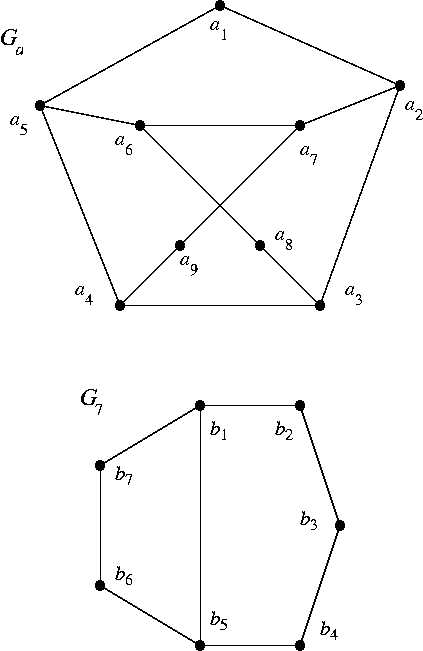
Homework Set X (4/1)
Sect. 8.1, ## 1-5, 7, 10.
# J1.
Sect. 8.1, ## 8, 9, 12, 13.
Sect. 9.1, ## 3, 4, 8, 12, 13.
## J3, J4(a, c, d).
Sect. 8.1, ## 6, 11.
Sect. 9.1, # 1, 7, 11.
## J2, J4(b, e), J5.
Definitions and Corrections
d) no edge passes through any vertex.
Problem Set J
(a) Prove chi(G) = 4.
(b) Is G critical?
(a) Fig. 9.1.19.
(b) Fig. 9.1.18.
(c) Fig. 9.1.17.
(d) Fig. 9.2.1, left.
(e) Fig. 9.2.1, right.
Homework Set XI and Problem Set K (4/14)
Sect. 8.2, ## 3, 4.
Sect. 8.3, ## 2, 3.
Sect. 8.4, ## 1, 2, 4, 7.
Sect. 9.1, ## 5, 6, 14.
## K1, K3(a).
Sect. 8.3, ## 4, 7.
Sect. 8.4, ## 5, 9.
## K2(a,b), K3(b), K4.
Sect. 9.1, # 15.
Sect. 8.2, ## 5, 6.
Sect. 8.4, ## 3, 6, 11.
## K2(c), K3(c).
Definitions and Corrections
Problem Set K
(b) Can K8 be decomposed into two planar graphs?
(c) Prove: if p >= 17, then Kp cannot be decomposed into three planar graphs.
(a) Fig. 2.3.6.
(b) Fig. 4.2.4.
(c) Fig. 1.3.3.
Homework Set XII and Problem Set L (4/23)
Sect. 8.4, # 8.
## L1(a), L2(a).
## L1(b), L2(b-d), L3.
Problem Set L
(a) Find cr(P), P = Petersen graph.
(b) Find cr(H), H = Heawood graph (Fig. 4.2.4).
(a) Prove: A cubic graph with girth g = 6 cannot be planar.
(b) Prove: A cubic graph with g >= 6 cannot be planar.
(c) Can a cubic graph with g = 5 be planar?
(d) Find a lower bound on cr(G) when G is cubic and has girth 6.
Homework Set XIII and Problem Set M (4/30)
Sect. 9.2, ## 1-4, 6, 7.
Sect. 9.3, ## 1-4, 6, 8.
## M1, M3, M4(a).
Sect. 9.3, # 7.
## M4(b), M5.
Sect. 9.3, ## 5, 9.
# M2.
Definitions, Statements, and Corrections
Problem Set M
(a) Prove Theorem M: If c(G) < min(c(K5), c(K3,3)), then G is planar. (Hint: Use Kuratowski's theorem.)
(b) Evaluate the minimum in Theorem M.
(c) Use (b) to solve Exercise 8.1.3. (If you didn't solve (b), just prove the minimum in (b) is > 3; that should be enough for Exercise 8.1.3.)
(a) Prove sigma(H) >= 2. (Hint: One way is to use Theorem L in Homework Set XII.)
(b) We know sigma(H) <= 3. Decide whether sigma(H) = 2 or 3.
Extra Problems (4/30)
Go to announcements | course information | homework list | previous homework
Problem Set N
(a) Prove that G5 cong P, where P = Petersen graph.
(b) Prove that, for any two vertices x, y of P, there is an isomorphism phi of P with itself such that phi(x) = y. (Technically, phi is the one-to-one correspondence between vertex sets. You can think of it as the function which tells you which vertex y will be relabelled x in the relabelling process.)
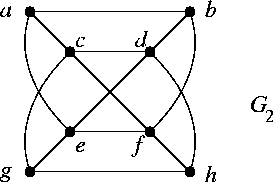
Go to announcements | course information.